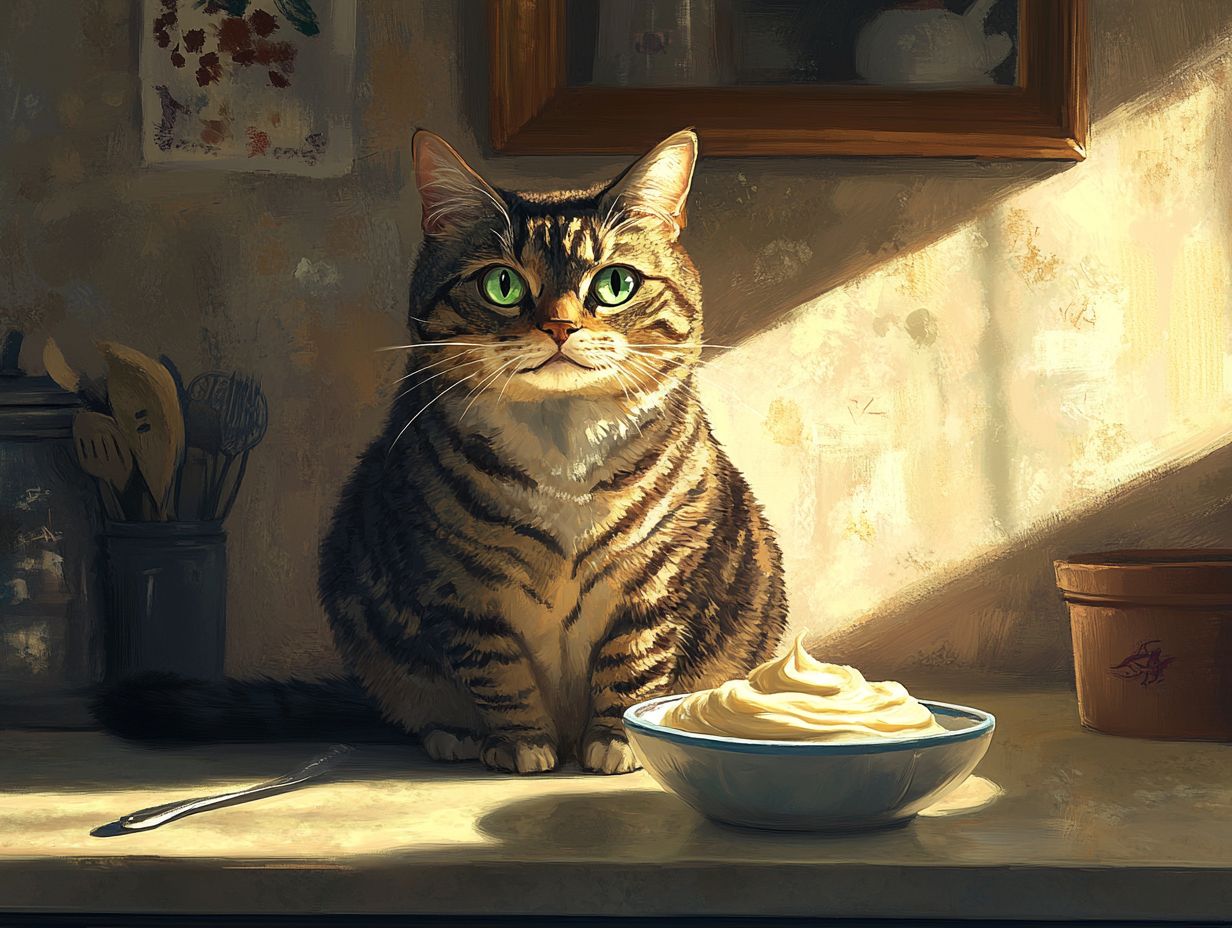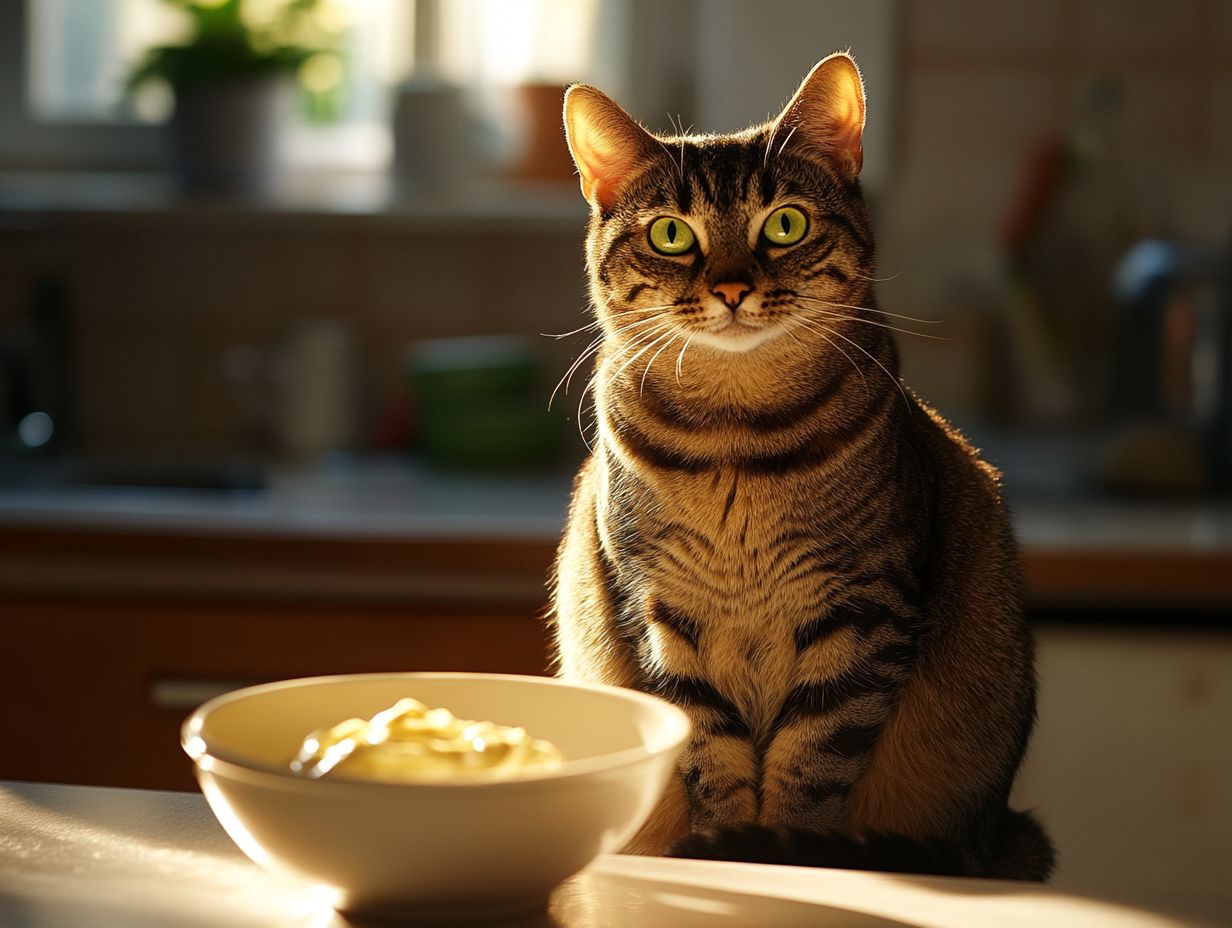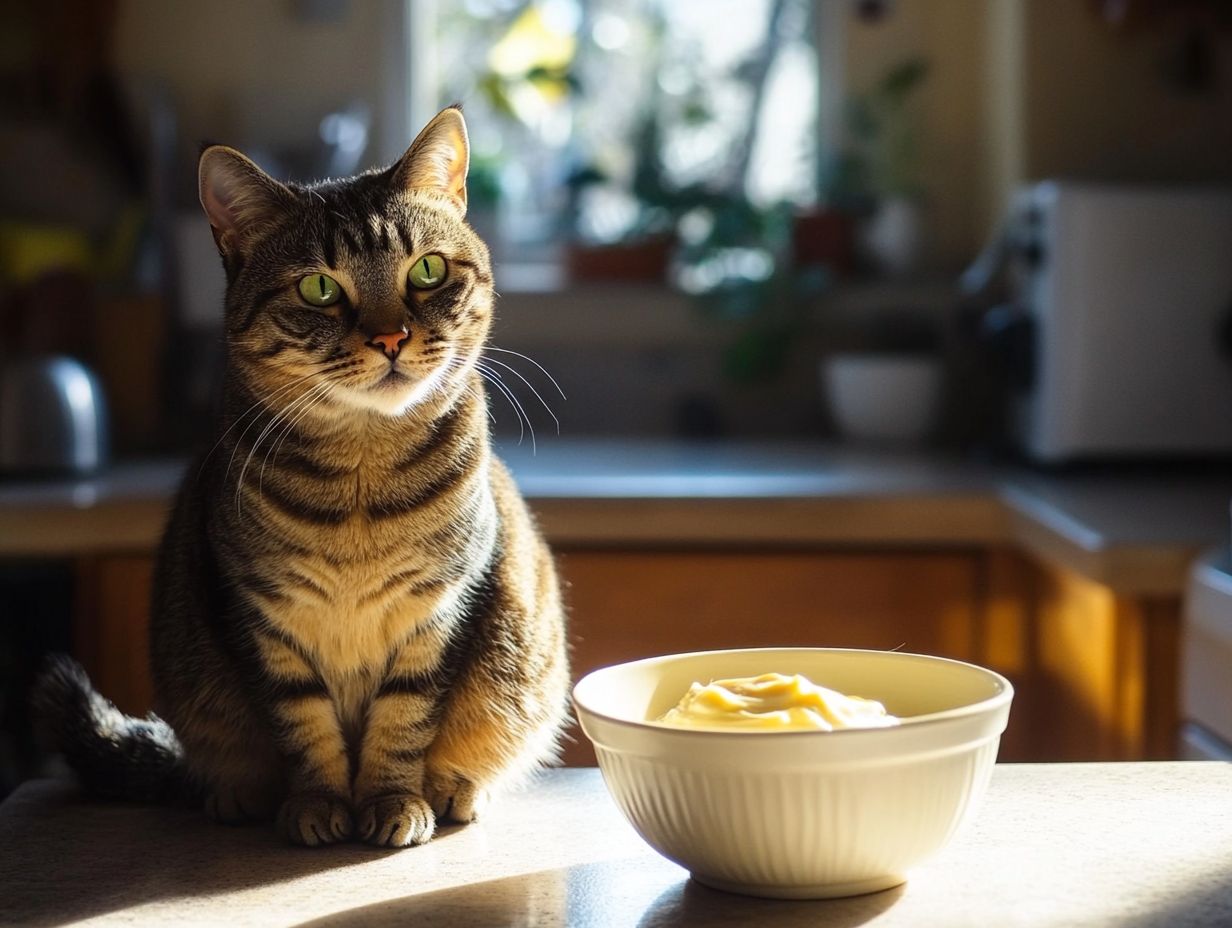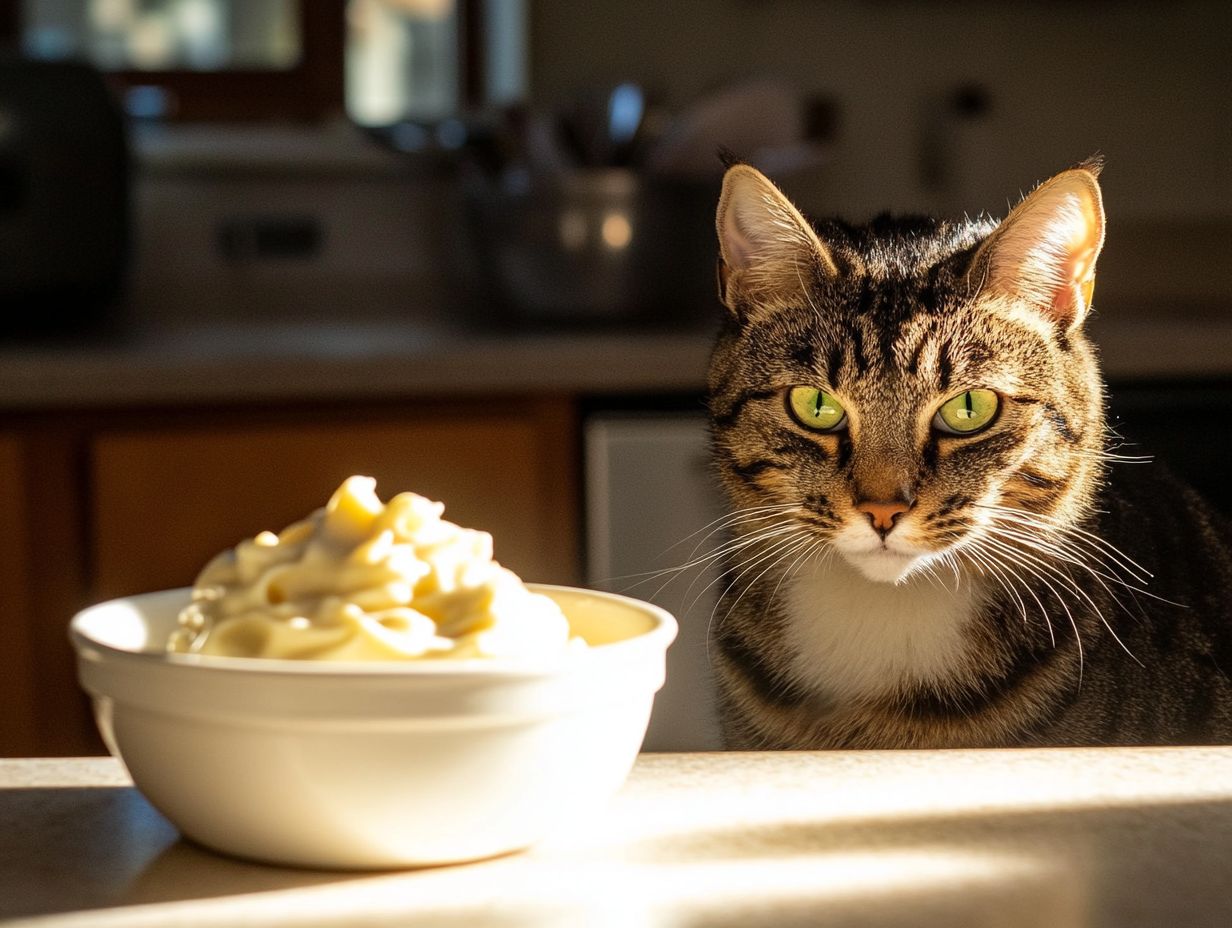Wondering if mayo is safe for your cat? Unfortunately, mayonnaise is not safe for cats. While this high-fat condiment might seem harmless, it poses potential health risks, such as obesity and digestive sensitivities.
This article explores the dangers of feeding mayo to cats, along with healthier cat treats that can keep them happy and nourished.
It also discusses the importance of a balanced cat diet, signs of food allergies to watch for, and tips for safely introducing new foods to cats.
Read on to ensure your cat’s diet is both safe and satisfying!
Key Takeaways:

- Avoid giving cats mayonnaise, as it can pose serious health risks, including stomach upset and pancreatitis.
- Safe and healthy treat options for cats include cooked meat (about 1 ounce), fish (like tuna, 1 teaspoon), and vegetables. These foods provide essential nutrients and are less likely to cause digestive issues or allergies.
- A balanced diet is crucial for a cat’s overall health and well-being. Proper nutrition can prevent health issues and increase their lifespan. Consult with a veterinarian or check resources like the American Veterinary Medical Association (AVMA) for advice on the best diet for your cat.
Can Cats Eat Mayonnaise?
Cats can eat mayonnaise, but it is not recommended. Mayonnaise is a high-fat condiment primarily composed of egg yolk, soybean oil, vinegar, and sometimes lemon juice. Ingredients in mayo such as these can be harmful to cats.
If you want to share human food with your cat, consider the impact of mayonnaise on their health, particularly in relation to obesity in cats and digestive sensitivities. The question of whether cats can eat mayonnaise is best addressed with vet advice, which can help ensure that cats receive a balanced diet while avoiding the potential risks associated with feeding them human food.
The Risks of Feeding Cats Mayonnaise
Feeding cats mayonnaise poses risks due to its high-fat content and certain ingredients that can be unhealthy for their digestive systems when consumed in large quantities. The rich composition of mayonnaise, primarily derived from oils and egg yolks, can lead to feline obesity if eaten excessively.
Additionally, the high cholesterol content may be particularly concerning for cats that already have heart disease. Cats with sensitive stomachs might experience digestive issues such as vomiting or diarrhea after consuming this condiment. Ingredients like garlic, salt, and sugar in mayonnaise can further exacerbate these issues.
It is advisable to consult a veterinarian before introducing any human food into a cat’s diet, as they can provide guidance tailored to the individual animal’s needs. For further reading, consider checking out articles from the AVMA.
Alternative Treats for Cats
Here are some safe and healthy alternatives to mayonnaise for cats. Cat owners should be mindful of the risks associated with feeding their feline companions mayonnaise and other human foods that are unsuitable for cats.
Instead, they should opt for safe alternatives specifically designed for feline health and digestion.
Safe and Healthy Options

Cat owners have a variety of safe and healthy treat options to offer their pets, including those containing good bacteria that support digestion and overall cat health. When integrated into a balanced diet, these veterinarian-approved treats can significantly enhance a cat’s digestive health and improve nutrient absorption. Many brands utilize all-natural ingredients, offering flavors such as chicken or fish that appeal to even the fussiest eaters while being gentle on their stomachs. Treats formulated with probiotics provide a tasty way for cat owners to promote their pets’ digestive health.
Some treats also include prebiotic fibers, which help maintain gut flora, allowing cats to enjoy their treats while reaping nutritional benefits. Additionally, treats that target specific issues like hairballs or obesity can be beneficial for feline health. Limit treats to no more than 10% of their daily caloric intake for optimal health.
Health Benefits of a Balanced Diet for Cats
In conclusion, while it might be tempting to share human foods like mayonnaise with your cat, it’s crucial to prioritize their health. Stick to safe and nutritious treats, maintain a balanced diet, and regularly consult veterinary resources for guidance on best feeding practices to ensure your feline friend thrives.
A balanced diet is crucial for your cat’s health and happiness. It helps prevent obesity and ensures they get vital nutrients like taurine, which is essential for feline health.
By understanding the dietary needs of cats, owners can make informed choices that enhance their pets’ longevity and vitality.
Why Nutrition is Important for Cats
Nutrition is fundamental to the health of cats, as it directly impacts their energy levels, weight management, and overall vitality. Providing good quality cat food is essential for preventing issues such as feline obesity and promoting optimal health. Consider choosing cat food that lists real meat as the first ingredient.
Veterinary professionals frequently emphasize the importance of a balanced diet tailored to a cat’s specific needs, which can help reduce the risk of chronic conditions. Cats require proteins, healthy fats, and essential vitamins, all of which contribute to maintaining a healthy weight and supporting their immune systems. Using portion control and feeding tools like the Hepper NomNom Cat Bowl can aid in maintaining a proper diet for cats.
Selecting cat food with minimal fillers and artificial additives can prevent unwanted weight gain, enhancing a cat’s quality of life. Incorporating portion control and establishing regular feeding schedules further supports weight management, ensuring that our furry companions lead their healthiest lives possible.
Signs of Food Allergies in Cats
It is crucial for cat owners to recognize the signs of food allergies in their pets, as these allergies can manifest in various ways and impact a cat’s overall health. Symptoms may include gastrointestinal upset, skin irritations, and behavioral changes. Food allergens in human food for cats might include ingredients like garlic or onions found in mayonnaise. Additionally, some human foods should never be fed to cats, such as chocolate or grapes.
Therefore, being aware of these signs is essential when introducing new human food to a cat’s diet.
Identifying and Addressing Allergies

Cat owners should identify specific food allergens affecting their pets and adhere to a veterinarian’s tailored recommendations and management plans to effectively address food allergies in cats. This process typically begins with an elimination diet, usually lasting 8-12 weeks, during which owners remove certain ingredients from their cat’s food for a designated period.
By monitoring changes in the cat’s health and behavior during this dietary change, owners can identify which ingredients trigger allergic reactions. Keeping a symptom diary can also be beneficial; by recording any signs of discomfort, such as licking, itching, or gastrointestinal issues, owners can provide valuable information to the veterinarian regarding the health changes observed in their feline companions. For those wondering about specific foods, such as mayonnaise, check out this article on Can Cats Eat Mayonnaise? What to Know. Ingredients like sugar or salt found in human foods should be monitored closely.
The veterinarian’s role is to interpret these observations, guide owners through the elimination process, and develop an effective management plan to ensure the cat’s overall well-being.
How to Safely Introduce New Foods to Cats
Introducing new foods into a cat’s diet is a delicate process. Cats have sensitive stomachs and may experience adverse reactions when new foods are introduced. High-calorie human foods can be especially challenging for cats.
It is important to carefully consider both the type and amount of food added, and the transition should be gradual. Safe food options include cooked chicken (about 1 ounce) or pumpkin. By following established guidelines and seeking professional advice from their veterinarian, cat owners can promote healthy eating habits and minimize the risk of digestive issues for their cats.
Tips for Introducing New Foods
When introducing new foods to your cat, it is essential to do so gradually and to monitor for any negative reactions to ensure they can adapt without discomfort or adverse health effects. This gradual approach allows the cat’s digestive system to slowly adjust to the new foods, minimizing the risk of gastrointestinal upset during the transition.
Frequently Asked Questions
Can Cats Eat Mayonnaise?

It’s generally not recommended for cats to eat mayonnaise as it is high in fat and can cause digestive issues (source: American Veterinary Medical Association).
What ingredients in mayonnaise can be harmful to cats?
Mayonnaise contains garlic and onions, both of which are toxic to cats. While raisins are not typically present in mayonnaise, they should be mentioned as a general caution for cats.
Can cats have a small amount of mayonnaise as a treat?
While it is unlikely to harm your cat, it’s best to avoid giving them mayonnaise as a treat due to its high-fat content.
What should I do if my cat accidentally eats mayonnaise?
If your cat accidentally consumes mayonnaise, monitor them for any signs of vomiting, diarrhea, changes in appetite, or altered behavior. If they show any symptoms, consult your vet immediately.
Are there any alternatives to mayonnaise that are safe for cats to eat, considering their unique cat digestion needs?
Plain, unsweetened yogurt can be a safe alternative to mayonnaise for cats, if they do not have lactose intolerance. A suggested portion size is about a teaspoon, but always start with a smaller amount to see how they react. If your cat experiences stomach upset or changes in behavior after consuming dairy, they may be lactose intolerant.
Why is it important to be cautious about what foods cats eat?
Cats have different dietary needs than humans, and some foods that are safe for us can be harmful to them. It’s important to always research and consult with a veterinarian or refer to resources like the American Veterinary Medical Association and PangoVet before feeding your cat any human foods.
In conclusion, while mayonnaise and some human foods may seem harmless, always consult with a veterinarian before introducing new foods into your cat’s diet. Ensuring your cat’s health and safety should always be the top priority.